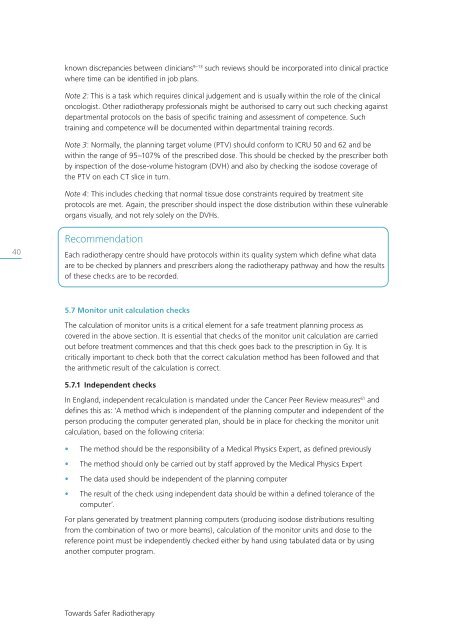Towards Safer Radiotherapy
Towards Safer Radiotherapy
Towards Safer Radiotherapy
Create successful ePaper yourself
Turn your PDF publications into a flip-book with our unique Google optimized e-Paper software.
known discrepancies between clinicians 9–13 such reviews should be incorporated into clinical practice<br />
where time can be identified in job plans.<br />
Note 2: This is a task which requires clinical judgement and is usually within the role of the clinical<br />
oncologist. Other radiotherapy professionals might be authorised to carry out such checking against<br />
departmental protocols on the basis of specific training and assessment of competence. Such<br />
training and competence will be documented within departmental training records.<br />
Note 3: Normally, the planning target volume (PTV) should conform to ICRU 50 and 62 and be<br />
within the range of 95–107% of the prescribed dose. This should be checked by the prescriber both<br />
by inspection of the dose-volume histogram (DVH) and also by checking the isodose coverage of<br />
the PTV on each CT slice in turn.<br />
Note 4: This includes checking that normal tissue dose constraints required by treatment site<br />
protocols are met. Again, the prescriber should inspect the dose distribution within these vulnerable<br />
organs visually, and not rely solely on the DVHs.<br />
40<br />
Recommendation<br />
Each radiotherapy centre should have protocols within its quality system which define what data<br />
are to be checked by planners and prescribers along the radiotherapy pathway and how the results<br />
of these checks are to be recorded.<br />
5.7 Monitor unit calculation checks<br />
The calculation of monitor units is a critical element for a safe treatment planning process as<br />
covered in the above section. It is essential that checks of the monitor unit calculation are carried<br />
out before treatment commences and that this check goes back to the prescription in Gy. It is<br />
critically important to check both that the correct calculation method has been followed and that<br />
the arithmetic result of the calculation is correct.<br />
5.7.1 Independent checks<br />
In England, independent recalculation is mandated under the Cancer Peer Review measures 61 and<br />
defines this as: ‘A method which is independent of the planning computer and independent of the<br />
person producing the computer generated plan, should be in place for checking the monitor unit<br />
calculation, based on the following criteria:<br />
• The method should be the responsibility of a Medical Physics Expert, as defined previously<br />
• The method should only be carried out by staff approved by the Medical Physics Expert<br />
• The data used should be independent of the planning computer<br />
• The result of the check using independent data should be within a defined tolerance of the<br />
computer’.<br />
For plans generated by treatment planning computers (producing isodose distributions resulting<br />
from the combination of two or more beams), calculation of the monitor units and dose to the<br />
reference point must be independently checked either by hand using tabulated data or by using<br />
another computer program.<br />
<strong>Towards</strong> <strong>Safer</strong> <strong>Radiotherapy</strong>



